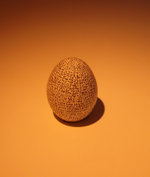Adam
Adam | |
|---|---|
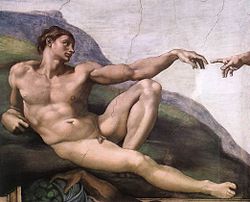 | |
| Era | Edenic and Antediluvian |
| Spouse | Eve[a] |
| Children | Cain, Abel and Seth[b] |
Adam | |
|---|---|
 A Byzantine mosaic in Monreale depicting Adam encountering the pre-incarnate Jesus at the Garden of Eden | |
| The Patriarch | |
| Born | Day 6, 1 AM Garden of Eden |
| Died | c. 930 AM |
| Venerated in | Christianity (Catholic Church, Eastern Orthodox Church, Oriental Orthodox Churches) Islam Druze[1][2] Baháʼí Faith Mandaeism |
| Feast | 24 December[3] (Catholic Church) Sunday of the Holy Forefathers (Eastern Orthodox Church) |
| Patronage | Gardeners and tailors |
Adam[c] is the name given in Genesis 1-5 to the first human.[4] Adam is the first human-being aware of God, and features as such in various belief systems (including Judaism, Gnosticism, Christianity, and Islam).[5]
According to Christianity, Adam sinned in the Garden of Eden by eating from the Tree of Knowledge. This action introduced death and sin into the world. This sinful nature infected all his descendants, and led humanity to be expelled from the Garden. Only through the Crucifixion of Jesus, humanity can be redeemed.
In Islam, Adam is considered Khalifa (خليفة) (successor) on earth. This is understood to mean either that he is God's deputy, the initiation of a new cycle of sentient life on earth, or both.[6] Similar to the account in the Bible, according to the Quran, Adam is placed in a Garden. Tempted by the Tree of Immortality, he sins and loses his abode in the Garden. When Adam repents from his sin, he is forgiven by God. This is seen as a guidance for human-life, who sin, become aware of their mistake, and repent.[7]
In Gnostic belief-systems, the bodily creation of Adam is viewed in a negative light. Due to the underlying demonization of matter, Gnostic cosmologies depict the body as a form of prison of Adam's soul. This soul would have been transferred by Sophia (wisdom) onto the creator (Demiurge) of the material world, who in turn is tricked into blowing the soul into a body. From this body, Adam rises up and becomes a sentient being. However, to escape from the world of matter, he needs to attain Gnosis.[8]
Composition of the Adam narrative

In Genesis 1-5 the name is given to the first human.[4] Beyond its use as the name of the first man, adam is also used in the Bible as a pronoun, individually as "a human" and in a collective sense as "mankind".[4] Genesis 1 tells of God's creation of the world and its creatures, including adam, meaning humankind; in Genesis 2 God forms "Adam", this time meaning a single male human, out of "the dust of the ground", places him in the Garden of Eden, and forms a woman, Eve, as his companion; in Genesis 3 Adam and Eve eat the fruit of the tree of knowledge and God condemns Adam to labour on the earth for his food and to return to it on his death; Genesis 4 deals with the birth of Adam's sons, and Genesis 5 lists his descendants from Seth to Noah.
In the entire Hebrew Bible, Adam appears only in chapters 1–5 of the Book of Genesis, with the exception of a mention at the beginning of the Books of Chronicles where, as in Genesis, he heads the list of Israel's ancestors.[9] The majority view among scholars is that the final text of Genesis dates from the Persian period (the 5th century BCE),[10] but the absence of all the other characters and incidents mentioned in chapters 1–11 of Genesis from the rest of the Hebrew Bible has led a sizeable minority to the conclusion that these chapters were composed much later than those that follow, possibly in the 3rd century BCE.[11]
Usage
Mankind—human being—male individual
The Bible uses the word אָדָם ( 'adam ) in all of its senses: collectively ("mankind", Genesis 1:27), individually (a "man", Genesis 2:7), gender nonspecific ("man and woman", Genesis 5:1–2), and male (Genesis 2:23–24).[4] In Genesis 1:27 "adam" is used in the collective sense, and the interplay between the individual "Adam" and the collective "humankind" is a main literary component to the events that occur in the Garden of Eden, the ambiguous meanings embedded throughout the moral, sexual, and spiritual terms of the narrative reflecting the complexity of the human condition.[12] Genesis 2:7 is the first verse where "Adam" takes on the sense of an individual man (the first man), and the context of sex is absent; the gender distinction of "adam" is then reiterated in Genesis 5:1–2 by defining "male and female".[4]
Connection to the earth
A recurring
In the Hebrew Bible
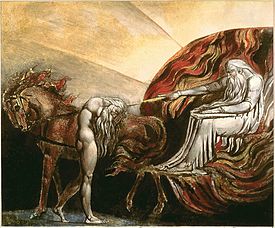
Genesis 1 tells of God's creation of the world and its creatures, with humankind as the last of his creatures: "Male and female created He them, and blessed them, and called their name Adam ..." (Genesis 5:2). God blesses mankind, commands them to "be fruitful and multiply", and gives them "dominion over the fish of the sea, and over the fowl of the air, and over the cattle, and over all the earth, and over every creeping thing that creepeth upon the earth" (Genesis 1.26–27).
In Genesis 2, God forms "Adam", this time meaning a single male human, out of "the dust of the ground" and "breathed into his nostrils the breath of life" (Genesis 2:7). God then places this first man in the Garden of Eden, telling him that "Of every tree of the garden thou mayest freely eat: But of the tree of the knowledge of good and evil, thou shalt not eat of it: for in the day that thou eatest thereof thou shalt surely die" (Genesis 2:16–17). God notes that "It is not good that the man should be alone" (Genesis 2:18) and brings the animals to Adam, who gives them their names, but among all the animals there was not found a companion for him (Genesis 2:20). God causes a deep sleep to fall upon Adam and forms a woman (Genesis 2:21–22), and Adam awakes and greets her as his helpmate.
Genesis 3, the account of the Fall: A serpent persuades the woman to disobey God's command and eat of the tree of knowledge, which gives wisdom. Woman convinces Adam to do likewise, whereupon they become conscious of their nakedness, cover themselves, and hide from the sight of God. God questions Adam, who blames the woman. God passes judgment, first upon the serpent, condemned to go on his belly, then the woman, condemned to pain in childbirth and subordination to her husband, and finally Adam, who is condemned to labour on the earth for his food and to return to it on his death.[14] God then expels the man and woman from the garden, lest they eat of the Tree of Life and become immortal.
The chiastic structure of the death oracle given to Adam in Genesis 3:19 forms a link between man's creation from "dust" (Genesis 2:7) to the "return" of his beginnings.[15]
- A you return
- B to the ground
- C since (kî ) from it you were taken
- C' for (kî ) dust you are
- B' and to dust
- B to the ground
- A' you will return
Genesis 4 deals with the birth of Adam's sons Cain and Abel and the story of the first murder, followed by the birth of a third son, Seth. Genesis 5, the Book of the Generations of Adam, lists the descendants of Adam from Seth to Noah with their ages at the birth of their first sons (except Adam himself, for whom his age at the birth of Seth, his third son, is given) and their ages at death (Adam lives 930 years, up to the 56th year of Lamech, father of Noah). The chapter notes that Adam had other sons and daughters after Seth, but does not name them.
Post-Biblical Jewish traditions
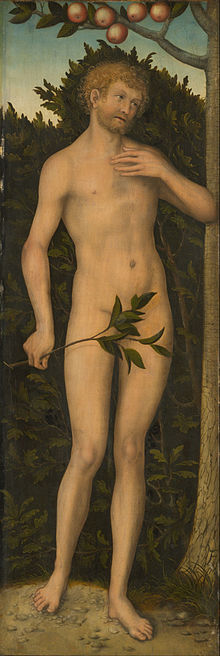
Body
Louis Ginzberg retells a midrash that God himself took dust from all four corners of the earth, and with each color (red for the blood, black for the bowels, white for the bones and veins, and green for the pale skin), created Adam.[16] The soul of Adam is the image of God, and as God fills the world, so the soul fills the human body: "as God sees all things, and is seen by none, so the soul sees, but cannot be seen; as God guides the world, so the soul guides the body; as God in His holiness is pure, so is the soul; and as God dwells in secret, so doth the soul."[17] According to Jewish literature, Adam possessed a body of light, identical to the light created by God on the first day,[18] and the original glory of Adam can be regained through mystical contemplation of God.[19]
Adam, Lilith and Eve
The rabbis, puzzled by fact that Genesis 1 states that God created man and woman together while Genesis 2 describes them being created separately, told that when God created Adam he also created a woman from the dust, as he had created Adam, and named her
Eve's fault in the Fall
The serpent approached Eve rather than Adam because Adam had heard the word of God with his own ears, whereas Eve had only his report; Eve tasted the fruit and knew at once that she was doomed to death, and said to herself that it was better she trick Adam into eating so that he too would die, and not take another woman in her place.[22] Adam ate the fruit unaware of what he was doing, and was filled with grief.[22] When Adam blamed Eve after eating the forbidden fruit, God rebuked him that Adam as a man should not have obeyed his wife, for he is the head, not her.[23]
Adam and the winter solstice
An
Children of Adam and Eve
Adam withdrew from Eve for 130 years after their expulsion from Eden, and in this time both he and Eve had sex with demons, until at length they reunited and Eve gave birth to Seth.
Adam's death and burial
The
According to the
Attitude towards Adam
In the 17th-century book Kav ha-Yashar, the author warns not to talk negatively about Adam, and writes that those who talk positively about Adam will be blessed with a long life.[30] A similar warning can be found in The Zohar.[31]
Adam and the angel Raziel
The
In Christianity
Original sin
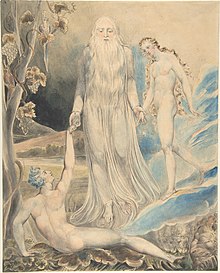
The idea of original sin is not found in Judaism nor in Islam, and was introduced into Christianity by the
Adam's grave: Golgotha replaces Solomon's Temple
As mentioned
In Mandaeism
In Mandaeism, Adam is considered the founder of the religion and the first prophet. He heralds manda (knowledge) and the true path of enlightenment. He is viewed as the propagator of kushta or divine truth.[41]: 31, 45 According to the Mandaean calendar, 2021–2022 CE in the Gregorian calendar would correspond to the Mandaean year 445391 AA (AA = after the creation of Adam).[42]
In Gnosticism
In the ancient
In Islam

In Islam,
Adam and Eve both ate of the
According to
According to the Ahmadiyya sect Adam was not the first human being on earth, but when the human race came into existence, and spread all over the world and developed the ability to receive revelation, God sent Adam to each and every branch of civilization. According to a revelation received by Mirza Ghulam Ahmad, the founder of the community, the Adam mentioned in the Quran was born 4,598 years before Muhammad.[48]
The Muslim thinker Nasir Khusraw offers another interpretation of Adam's significance to the Islamic religious tradition. He writes that Adam was the first enunciator of divine revelation (nāṭiq) and Seth was his legatee (wasī). He argues that the descendants of Seth are Imams, culminating in the seventh Imam, Nuh/Noah who, in addition to holding the Imamate, would also hold the position of enunciator.[49]
In the Islamic traditions (hadith), Adam is given the name by God known as the (Adam-I-Safi) or The Chosen One.[50][51]
In Druze faith
The Druze regard Adam as the first spokesman (natiq), who helped to transmit the foundational teachings of monotheism (tawhid) intended for a larger audience.[52] He is also considered an important prophet of God in Druze faith, being among the seven prophets who appeared in different periods of history.[1][2]
In other religions and unorthodox practices
Some Taoists in the Tang dynasty, inspired by Emperor Taizong's syncretic beliefs and policies encouraging it, viewed the Christian version of Jesus as a redemptive manifestation of "the Way",[53] and respected his ancestors, including Adam, as well.
Some Mongolian Christians and Muslims thought Adam was the same person as Gautama Buddha.[54]
Historicity
While a traditional view was that the Book of Genesis was authored by Moses and has been considered historical and metaphorical, modern scholars consider the Genesis creation narrative as one of various ancient origin myths.[55][56]
Analysis like the documentary hypothesis also suggests that the text is a result of the compilation of multiple previous traditions, explaining apparent contradictions.[57][58] Other stories of the same canonical book, like the Genesis flood narrative, are also understood as having been influenced by older literature, with parallels in the older Epic of Gilgamesh.[59]
Genetical analysis
In biology, the
See also
- Adam's grave or burial site of his skull
- Cave of Machpelahin Hebron; according to traditional Jewish belief
- Apocalypse of Moses
- Golgotha; now Adam's Chapel in the Church of the Holy Sepulchre, Jerusalem; according to Christian tradition based on the Apocalypse of Moses
- Monastery of the Cross in Jerusalem; according to Christian tradition
- Imam Ali Mosquein Najaf; according to Shia tradition, after Noah buried him there following the deluge.
- Adam–God doctrine
- Adam Kadmon
- Adam kasia
- Adam pagria
- Adapa
- Banu (Arabic)
- Eve
- List of Old Testament pseudepigrapha
- Mahabad (prophet)
- Manu
- Shiva
- Paradise Lost
- Table of prophets of Abrahamic religions
- Y-chromosomal Adam
Notes
References
Citations
- ^ ISBN 978-1-4655-4662-3.
- ^ ISBN 978-1-903900-36-9.
- ^ The Slaves of the Immaculate Heart of Mary (24 December 2000). "Saint Adam and Saint Eve (First Age of the world)". Catholicism.org. Retrieved 22 December 2021.
- ^ a b c d e Hendel 2000, p. 18.
- ^ Chipman, Leigh NB. "Mythic Aspects of the Process of Adam's Creation in Judaism and Islam." Studia Islamica (2001): 5-25.
- ISBN 978-0-87395-727-4p. 73
- ^ Stieglecker, H. (1962). Die Glaubenslehren des Islam. Deutschland: F. Schöningh
- ^ Chipman, Leigh NB. "Mythic Aspects of the Process of Adam's Creation in Judaism and Islam." Studia Islamica (2001): 5-25.
- ^ Enns 2012, p. 84.
- ^ Cosgrove 2004, p. 168.
- ^ Gmirkin 2006, pp. 240–241.
- ^ Hendel 2000, p. 18-19.
- ^ a b Hendel 2000, p. 119.
- ^ Mathews 1996, p. 252
- ^ Mathews 1996, p. 253
- ^ Ginzberg 1909, vol I, chapter II.
- ^ Ginzberg 1909, vol I, chapter II
Citation: "God had fashioned his (Adam's) soul with particular care. She is the image of God, - ^ Schwartz 2006, p. 130.
- ^ a b c Hendel 2000, p. 19.
- ^ a b Schwartz 2006, p. 218.
- ^ Schwartz 2006, p. 138.
- ^ a b Schwartz 2006, p. 434-435.
- ^ Ginzberg 1909, p. 36-37.
- ^ Jubilees 4:1.
- ^ Jubilees 4:9
- ^ Jubilees 4:10
- ^ Schwartz 2006, p. 445.
- ^ Schwartz 2006, p. 437.
- ^ a b Ginzberg 1998, p. 125-126.
- ^ Parshat Chukat
- ^ Zohar Chadash Parshat Beresheit 24a or in older versions 19
- ^ "Raziel, Book of". Jewish Encyclopedia (1906).
- ^ Morris Eaves; Robert N. Essick; Joseph Viscomi (eds.). "The Creation of Eve: "And She Shall Be Called Woman", object 1 (Butlin 435) "The Creation of Eve: "And She Shall Be Called Woman""". William Blake Archive.
- ^ Pies 2000, p. xviii.
- ^ a b c Boring 2012, p. 301.
- ^ Stortz 2001, p. 93.
- ^ Stortz 2001, pp. 93–94.
- ^ Stortz 2001, p. 94.
- ^ Ginzberg 1998, p. 126.
- ^ Hanauer 2011, pp. 69–70.
- ^ Brikhah S. Nasoraia (2012). "Sacred Text and Esoteric Praxis in Sabian Mandaean Religion" (PDF).
- OCLC 68208613.
- ISBN 978-1-59030-631-4. Retrieved 2021-10-17.
- ^ Wheeler 2002, pp. 17–18.
- ^ Wheeler 2002, p. 15.
- ^ Wheeler 2002, p. 25,30.
- ^ Wheeler 2002, p. 32,39,43.
- ^ "Man Lived on Earth Even Before the Advent of Adam". Al Islam. 2000-02-16.
- ^ Virani, Shafique (January 2005). "The Days of Creation in the Thought of Nasir Khusraw". Nasir Khusraw: Yesterday, Today, Tomorrow.
- .
Adam was given the honorary name of "Adam-I-Safi" meaning: The Chosen One
- ^ Anand, K.D.W. "The Christ of the Quran" (PDF). biblicalstudies.org.uk. p. 57.
Adam was God's Chosen one "Adam-Safi"
- ^ Swayd 2009, p. 3.
- OCLC 123079516.
- OCLC 46661540.
- ISBN 978-0-664-25652-4.
- ISBN 978-0-19-875500-5.
- ISBN 978-0-567-08418-7.
- ISBN 978-0-567-08088-2.
- ISBN 978-1-4447-5707-1.
- PMID 8450756.
Bibliography
- Boring, Eugene (2012). An Introduction to the New Testament: History, Literature, Theology. Westminster John Knox. ISBN 978-0-664-25592-3.
- Cosgrove, Charles H. (2004). The Meanings We Choose: Hermeneutical Ethics, Indeterminacy and the Conflict of Interpretations. Bloomsbury Publishing. ISBN 978-0-567-06896-5.
- Enns, Peter (2012). The Evolution of Adam: What the Bible Does and Doesn't Say about Human Origins. Baker Books. ISBN 978-1-58743-315-3.
- Ginzberg, Louis (1998). The Legends of the Jews: From the Creation to Exodus: Notes for Volumes 1 and 2. JHU Press. ISBN 978-0-8018-5894-9.
- Ginzberg, Louis (1909). The Legends of the Jews (PDF). Translated by Henrietta Szold. Philadelphia: Jewish Publication Society.
- Gmirkin, Russell E. (2006). Berossus and Genesis, Manetho and Exodus. Bloomsbury. ISBN 978-0-567-13439-4.
- Hanauer, J.E. (2011). Folklore of the Holy Land. The Other Press. ISBN 978-967-5062-56-8.
- Hendel, Ronald S (2000). "Adam". In David Noel Freedman (ed.). Eerdmans Dictionary of the Bible. Eerdmans. ISBN 978-90-5356-503-2.
- Mathews, K. A. (1996). Genesis 1–11:26. ISBN 978-0-8054-0101-1.
- Pies, Ronald W. (2000). The Ethics of the Sages: An Interfaith Commentary on Pirkei Avot. Jason Aronson. ISBN 978-0-7657-6103-3.
- ISBN 978-0-19-532713-7.
- Stortz, Martha Ellen (2001). "Where or When Was Your Servant Innocent?". In Bunge, Marcia J. (ed.). The Child in Christian Thought. Eerdmans. ISBN 978-0-8028-4693-8.
- Wheeler, Brannon M. (2002). Prophets in the Quran: An Introduction to the Quran and Muslim Exegesis. A&C Black. ISBN 978-0-8264-4957-3.
- Womack, Mari (2005). Symbols and Meaning: A Concise Introduction. AltaMira Press. ISBN 978-0-7591-0322-1.
- Swayd, Samy S. (2009). The a to Z of the Druzes. ISBN 978-0-8108-6836-6.
External links
 Media related to Adam (Biblical figure) at Wikimedia Commons
Media related to Adam (Biblical figure) at Wikimedia Commons Quotations related to Adam at Wikiquote
Quotations related to Adam at Wikiquote

